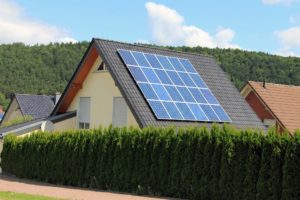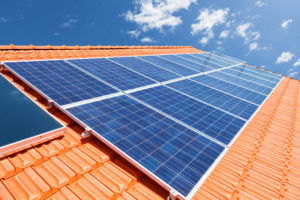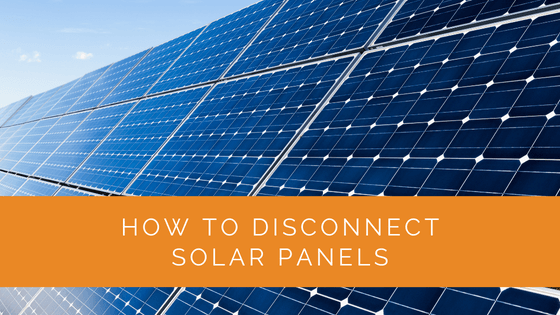Disconnecting solar panels from your home’s power system may seem straightforward, but it requires careful consideration and a methodical approach to ensure safety and prevent damage. Whether preparing for a few days away, facing a storm warning, or simply performing maintenance, understanding the proper steps to disconnect your solar panels safely is crucial. This article outlines a comprehensive, step-by-step guide to help you confidently navigate the process. From wearing the appropriate safety gear to selecting the optimal time of day and carefully handling electrical components, each step ensures a safe and efficient disconnection, minimizing fire, electrocution, and system damage risks.
Contents
- 1 Key Takeaways
- 2 Things to Consider Before Disconnecting a Solar Panel
- 3 5 Steps to Safely Disconnect Solar Panels
- 3.1 Step #1: Turning Off the AC and DC Switches to Cut Off Solar Power Flow
- 3.2 Step #2: Covering the Solar Panel to Stop It from Producing Electricity
- 3.3 Step #3: Checking the Voltage Meter and Measuring the String of Modules
- 3.4 Step #4: Disconnect the MC4 Connectors and Wires from The Solar Panels
- 3.5 Step #5: Seal the Plugs with Electrical Tape and Dismount the Solar Panels
- 4 Can You Leave Solar Panels Disconnected?
- 5 Case Study: Safely Disconnecting Solar Panels
- 6 Expert Insights From Our Solar Panel Installers About Disconnecting Solar Panels
- 7 Experience Solar Excellence with Us!
- 8 The Bottom Line
Key Takeaways
- Solar panels can be safely disconnected by following specific steps and safety precautions essential for maintenance or during extended periods of inactivity.
- To safely disconnect solar panels, homeowners should turn off AC and DC switches, cover the panels to prevent electricity generation, check the voltage to ensure safety, unplug connectors and wires, and secure loose wires.
- Disconnecting solar panels for extended periods is not recommended, as it can lead to potential harm and overload the system due to unattached circuits and residual power. It should ideally only be done for two to three days when necessary.
Things to Consider Before Disconnecting a Solar Panel
Even with a rapid shutdown disconnection requirement in the United States, knowing the intricacies of shutting down a solar power system is crucial. But, before you can push that disconnect switch, you must take some preventive measures.
- Wear great safety gear like insulating gloves, fire-rated clothes, clamping devices, safety glasses, work boots, and a hard hat.
- Select the correct hour. Early evening or at the break of dawn, because the more the sun’s energy, the more the voltage in the panels.
- Disconnect the DC and AC switches before disconnecting the solar panels from the grid.
If you adhere to all these, you can easily avoid fire and electrocution while disconnecting solar panels.

5 Steps to Safely Disconnect Solar Panels
Most homeowners want to disconnect their solar system when away for a few days or if there is a storm warning. In such scenarios, shutting down the panels is a must.
Step #1: Turning Off the AC and DC Switches to Cut Off Solar Power Flow
The first step would be to turn off the circuit breaker. Most installations in America will have an AC disconnect switch connected to the inverter.
Find this on your panels and turn it off. Additionally, turn off the DC power disconnect switches.
You can find both the disconnect switches of the alternating current and the direct current connected to the main electrical panel secured to the inverter input or combiner box.
Step #2: Covering the Solar Panel to Stop It from Producing Electricity
Did you know that the slightest bit of sunlight can activate the solar cells on your panels? So, cover your panels with an opaque surface to stop them from generating power.
This step is crucial because it cuts off the sunlight, stops your panels from producing energy, and saves you from electrocution.

Step #3: Checking the Voltage Meter and Measuring the String of Modules
After this, you should turn on your meter and measure the current. This process will allow you to avoid fire hazards or electrocution because you will use a multimeter to measure the voltage before moving forward.
You can touch the metal section in the positive probe to ensure the system is close to 0V. If it is at 0V, you can slowly disconnect through the terminal without worrying about electrocution.
Step #4: Disconnect the MC4 Connectors and Wires from The Solar Panels
Next, you must unplug the MC4 connectors. You can find these at the end of your solar panel, featuring a tool to help you disconnect. Such connectors are waterproof, so you will not find any visible conductors. Hence, it is crucial to look at the voltage of the solar panels before unplugging the MC4.
Step #5: Seal the Plugs with Electrical Tape and Dismount the Solar Panels
After unplugging the connectors, you should cover them with electrical tape. Next, unplug the wires using a socket wrench to loosen the screws or bolts that hold them together.
In some models, you should use a screwdriver because of the difference in connection terminals. This way, you can remove the screws holding the panels together if you want to remove the model altogether. Finally, secure the ends using a rubber terminal cover as it prevents physical contact with live wire connected to the batteries.

Can You Leave Solar Panels Disconnected?
Ideally, we will not recommend you unplug solar panels for long durations unless necessary.
Given its electrical load, a solar PV system will have unattached and open circuits that could be harmed. Moreover, the power outages transferred between these circuits would not have anywhere to go. As such, this current can overload your systems and damage the solar panel.
So, disconnecting solar panels should not be a regular occurrence and should ideally be only for two to three days.
Case Study: Safely Disconnecting Solar Panels
Background
The Hickman family, residing in Baton Rouge, Louisiana, recently faced a severe storm warning. With their home equipped with a solar panel system, they wanted to ensure that the panels were safely disconnected to prevent any damage or electrical hazards during the storm.
Project Planning and Objectives
The main objectives for the Hickman family were:
- Safely disconnect the solar panel system to prevent storm-related damage.
- Follow a step-by-step process to ensure no risk of electrocution or fire.
- Reconnect the system easily once the storm has passed.
They reached out to Solar Panels Network USA for guidance on the safest way to disconnect their solar panels.
Implementation
Solar Panels Network USA provided the Hickman family with detailed instructions and safety tips on disconnecting their solar panels. They were advised to turn off both AC and DC switches, cover the panels to prevent energy generation, and ensure all connections were securely covered and insulated.
With this guidance, the Hickmans successfully disconnected their solar panels before the storm. They felt confident in the process, knowing they had taken all necessary precautions to ensure safety.
Results and Benefits
By following these steps, the Hickman family successfully disconnected their solar panel system without any issues. They were able to weather the storm without worrying about potential electrical hazards or damage to their solar setup.
Safety and Peace of Mind:
- The Hickmans felt confident in their ability to manage their solar system safely.
- They avoided potential damage to their solar panels and electrical systems during the storm.
- The clear and methodical approach ensured no steps were missed, enhancing safety.
Efficient Reconnection: Once the storm had passed, reconnecting the system was straightforward. The clear labeling and secure connections ensured that the panels were back online quickly, restoring their renewable energy source without any complications.
Summary
The Hickman family’s experience in Baton Rouge, Louisiana, demonstrates the importance of following a detailed and safety-focused approach to disconnecting solar panels. With guidance from Solar Panels Network USA, they were able to protect their systems during severe weather, ensuring both their safety and the longevity of their solar investment. This case study highlights how homeowners can effectively manage their solar systems, even in challenging conditions, by following expert advice and maintaining a focus on safety.
Expert Insights From Our Solar Panel Installers About Disconnecting Solar Panels
Safety is paramount when disconnecting solar panels. Always start by turning off both AC and DC switches to cut off the power flow. This step minimizes the risk of electrocution and prevents potential damage to the system.
Covering the solar panels with an opaque material is crucial to stop them from generating electricity. Even a small amount of sunlight can activate the cells and produce current, so ensure the panels are fully covered before proceeding.
Using a voltage meter to check the current before disconnecting the wires is essential. This ensures that the system is safe to handle and prevents any unexpected electrical shocks.
Experience Solar Excellence with Us!
Trust in Solar Panels Network USA, where our seasoned experts deliver top-quality solar solutions for homes and businesses nationwide. With a legacy of countless successful installations and a commitment to sustainable energy, we’re your reliable partner in the solar journey. Ready for a brighter, eco-friendly future? Call us now at (855) 427-0058 and harness the sun’s power!
The Bottom Line
Now you know all about disconnecting solar panels, circuit breakers, and the rapid shutdown requirements. You can go off-grid for a few days by turning it off using the abovementioned steps. All you have to do is turn off the power supply, cover the panels, and remove the wire.
Disconnected solar array systems do not produce energy from the sun, but there can be residual power in the wire secured to the batteries. Hence, it would be best if you also secured any loose wires.
Lastly, consider the day timings before disconnecting the DC and AC power for added safety.
About the Author
Solar Panels Network USA stands at the forefront of solar energy solutions, driven by a team of seasoned solar engineers and energy consultants. With over decades of experience in delivering high-quality solar installations and maintenance, we are committed to promoting sustainable energy through customer-centric, tailored solutions. Our articles reflect this commitment, crafted collaboratively by experts to provide accurate, up-to-date insights into solar technology, ensuring our readers are well-informed and empowered in their solar energy decisions.

